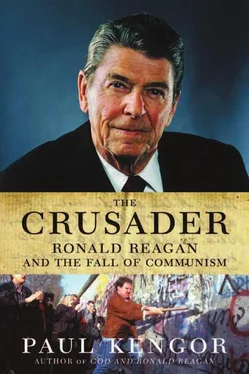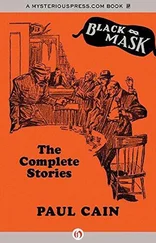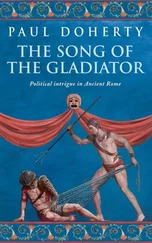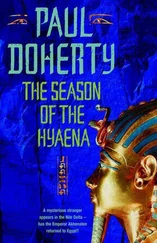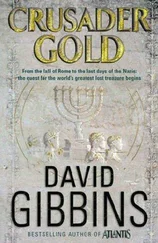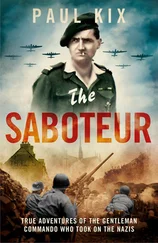44. Schweizer, Reagan’s War, 184–86.
45. NSDD-41, June 22, 1982. NSDD is on file at the Reagan Library. See Simpson, NSDDs of the Reagan and Bush Administrations, 68–69; and George Shultz, Turmoil and Triumph (New York: Scribner, 1993), 136.
46. NSDD-48, July 23, 1982. NSDD is on file at the Reagan Library.
47. Simpson, NSDDs of the Reagan and Bush Administrations, 71–72.
48. Interviews with Roger W. Robinson, June 6 and 8, 2005.
49. Ibid.
50. Leebaert, The Fifty-Year Wound, 523.
51. Interviews with Roger W. Robinson, June 6 and 8, 2005.
52. Bailey, The Strategic Plan That Won the Cold War, 8.
53. Ibid., 5.
54. Reagan, An American Life, 559.
55. NSDD-54, September 2, 1982. NSDD is on file at the Reagan Library.
56. NSDD-54, 2–4.
57. “After Détente, the Goal is to Prevail,” New York Times, September 23, 1982, B16.
58. Ibid.
59. Reagan, An American Life, 559.
60. Bill Clark frequently emphasizes that almost all of the products that came out of his NSC, from drafts of directives to speeches and more, were a “team effort.” He is reluctant to credit single individuals as sole authors, including himself. Various interviews with Bill Clark.
61. Interviews with Roger W. Robinson, June 6 and 8, 2005.
62. Peter Schweizer, Victory, 125–27.
63. Roger Robinson is the source for this item. He says that the group of individuals was roughly a dozen. See Robinson interviewed on the documentary In the Face of Evil: Reagan’s War in Word and Deed (American Vantage Films and Capital Films I, LLC, 2005). 64. Ibid. Robinson makes this point. These few individuals are quoted throughout this book, and obviously include the likes of Bill Clark and Bill Casey.
65. The latter was the title used by Christopher Simpson on page 80 of his book on Reagan’s NSDDs.
66. NSDD-66, November 29, 1982, 1. NSDD is on file at the Reagan Library. 67. Ibid., 1–2.
68. “Summary of Conclusions” addendum to NSDD-66, 1. On file at Reagan Library with NSDD-66.
69. NSDD-66, 2.
70. Schweizer, ed., Fall of the Berlin Wall, 34–38.
71. U.S. Department of Commerce, International Trade Administration, “Quantifications of Western Exports of High-Technology Products to Communist Countries Through 1983,” 1985, 12, 28–29; and “Geheimclub COCOM,” Die Zeit, October 10, 1983, 34. Credit goes to Peter Schweizer for locating these sources.
72. For more, see Schweizer’s various works.
73. Quoted in Don Oberdorfer, The Turn (New York: Poseidon, 1991), 76. 74. NSDD-70, November 30, 1982, 1–4. NSDD is on file at the Reagan Library. GMT on March 17, 1983. Transcripts are published as “‘Economic, Military Blackmail’” and “Directive 75 ‘Subversive’ Anti-Soviet Plan” in FBIS, FBIS-SOV-18-MAR-83, March 18, 1983, A8–9.
16. G. Dadyants, “Pipes Threatens History,” Sotsialisticheskaya Industriya, March 26, 1983, 3, published as “New Directive on USSR Trade ‘Threatens History,’” in FBIS, FBISSOV-29-MAR-83, March 29, 1983, A6–7.
17. For the record, Pipes did not learn of the Sotsialisticheskaya Industriya article until over twenty years after its publication, and was perplexed how a Soviet journalist had learned of the highly classified NSDD-75. Pipes told me: “Are you sure of this? NSDD-75 was highly classified—how would a Soviet journalist hear about it?” Correspondence with Richard Pipes, December 24, 2005.
18. Reagan, “Remarks at the National Leadership Forum of the Center for Strategic and International Studies of Georgetown University,” April 6, 1984.
19. He revisited this “economy first” point throughout 1984–85. Among others, see Reagan, “Address to the Nation and Other Countries on United States-Soviet Relations,” January 16, 1984; “Interview With Lou Cannon, David Hoffman, and Juan Williams of the Washington Post on Foreign and Domestic Issues,” January 16, 1984; “Remarks at the National Leadership Forum of the Center for Strategic and International Studies of Georgetown University,” April 6, 1984; and “State of the Union Address,” February 6, 1985.
20. Reagan, “Remarks at the Annual Washington Conference of the American Legion,” February 22, 1983.
21. V. Bolshakov wrote: “When the present U.S. Administration took office in 1981, wholesale ideological sabotage against the socialist countries was openly elevated to the rank of U.S. state policy.” The aim, said the Pravda analysis, was to “destabilize the existing system in the socialist community.” V. Bolshakov, “Washington ‘Crusaders’ on the March,” Pravda , January 31, 1983, 6, published as “ Pravda Accuses U.S. of ‘Ideological Aggression,’” in FBISSOV-9-FEB-83, February 9, 1983, A1–4.
22. Talk of an anti-Communist “crusade” was heard again at the time on Moscow’s “Studio 9” program, a popular television broadcast blessed by the benefits of a monopoly on both opinion and the airwaves. Moscow TV’s “Studio 9” program, February 26, 1983. Transcript published as “U.S. Anti-Communist ‘Crusade,’” in FBIS-SOV-28-FEB-83, February 28, 1983, CC11.
23. February 19, 1983 TASS statement. Text is published as “Leader Speeches Show ‘Crusade Against Communism,’” in FBIS-SOV-22-FEB-83, February 22, 1983, A5.
24. For a lengthy discussion, including sources on Reagan’s thinking, see chapter 16 of God and Ronald Reagan.
25. Reagan, “Remarks at the Annual Convention of the National Association of Evangelicals,” Orlando, Florida, March 8, 1983.
26. Clark in Schweizer, Fall of the Berlin Wall, 76.
27. Spencer shared this story with Tom Reed. Reed, At the Abyss, 240.
28. A marked-up draft of the speech on file at the Reagan Library, specifically in Folder 155, Box 9, of the Presidential Speeches section of the Presidential Handwriting File.
29. On this, Ed Meese is especially informative. Meese, With Reagan, 101–16. George Keyworth said that on the Saturday before the speech that Wednesday evening, “the only people who were knowledgeable, the only people who knew what was going on,” were Reagan, McFarlane, Poindexter, Clark, and himself. That was it. Only those five. “A day or so later,” Ray Pollock was “involved.” Closer to the time of the speech, Gil Rye also became involved. Rye wasn’t involved until the time came to write the necessary messages to various embassies. He confirmed that “it is true that not many people in the Defense Department had any idea that the President was going to make the speech.” He said Cap Weinberger and Richard Perle were both in Portugal for a NATO conference. “They knew something was happening,” said Keyworth, “but only on Sunday or Monday.” “It was most definitely a surprise,” summed Keyworth. Keyworth interviewed by Baucom, September 28, 1987, RRL, OHT, Folder 37, Box 8, 27–29.
30. Interview with Edward Teller, July 15, 2003. Also see transcript of Edward Teller interviewed by Donald Baucom, July 6, 1987, RRL, OHT, Folder 35, Box 8, 7–9. 31. I have discussed this with Bill Clark many times. Also see: Meese, With Reagan, 101–16.
32. Keyworth interviewed by Baucom, September 28, 1987, RRL, OHT, Folder 37, Box 8, 25.
33. Ibid., 25–26, 35.
34. Bill Clark, “President Reagan and the Wall,” Address to the Council of National Policy, San Francisco, California, March 2000, 8–9.
35. George Shultz said, “SDI was entirely the president’s idea.” George Keyworth added: “There was never any single initiative by the Reagan administration that was so thoroughly created and invented in Ronald Reagan’s own mind and experience. It was his decision. It was his creation.” For quotes, see D’Souza, Ronald Reagan, 175 and Ken Adelman, The Great Universal Embrace (New York: Simon & Schuster, 1989), 298. That said, there were a handful of men who were influential in Reagan’s thinking on missile defense, including Martin Anderson, Daniel O. Graham, Malcolm Wallop, Karl Bendetsen, James D. Watkins, Harrison H. Schmitt, Angelo Codevilla, and Edward Teller, among others. Especially important was a February 11, 1983 meeting between Reagan and his joint chiefs of staff. Among other sources, see William Broad, Teller’s War (Simon & Schuster, 1992), 96–120, 136.
Читать дальше
